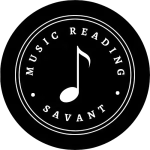| This reading music lesson is a supplement to the Alfred’s Essentials of Music Theory self-study workbook. While no book is perfect for learning how to read music, this is one of the best available. The concise explanations, brief practice exercises, ear-training CD’s, glossary of music terms, and answer key make it an excellent value. Buy this top-rated self-study course for beginners to advanced musicians and follow along with me. |
Okay, I’m glad that you know how to find “F” in the bass clef.
Now, we’re going to look at all the other bass clef notes.
Music Alphabet
Do you remember the music alphabet that we talked about a few lessons ago?
It’s time to use it again.
Up the Staff
When you move up the bass clef staff, you go through the music alphabet letter names in order.
A-B-C-D-E-F-G

Down the Staff
On the way down the staff, you go backwards through the alphabet.
G-F-E-D-C-B-A

Where Do I Start?
It doesn’t matter what pitch you start on. You will either go forward through the alphabet in order going up the staff or backwards through the letters moving down.
Review
Remember, as you move up the staff the pitches will sound higher. When you move down through the staff, the pitches will sound lower.
This is one way to learn how to read all the bass clef notes. There’s an even easier way we will talk about in the next 2 lessons. Let’s go on over to Bass Clef Line Notes – Reading Music Lesson #14

Teresa
I faintly remember a lesson years ago with the bass clef being read descending.
The spaces being: Give, Every, Child, Apples.
But I cannot recall the mnemonic for the line notes.
I hope you are well!
Sincerely
Cory